「ぼうさいこくたい」とは「大規模災害に備える- まなぶ・つながる・つよくなる – 防災を、もっと日常に」をテーマに、内閣府・防災推進協議会・防災推進国民会議が主催する国内最大級の総合防災イベントのことで、今年で4回目、それも名古屋で開催されるということで行ってきました。
It was a two-day event, but circumstances prevented me from going on the first day, so I went only on the second day.
I had checked the schedule for the day and made sure I had the places I wanted to see in advance, but I made the mistake of missing the morning session, which I thought would start at 10:30 a.m. It actually started at 10:00 a.m. I didn't want to see it from the middle of the day. I felt uncomfortable to watch from the middle of the day, so I went ahead and looked around.
Current status of the July 2008 torrential rain disaster and future efforts
In Chukyo TV
The first floor of Chukyo TV was also a venue.
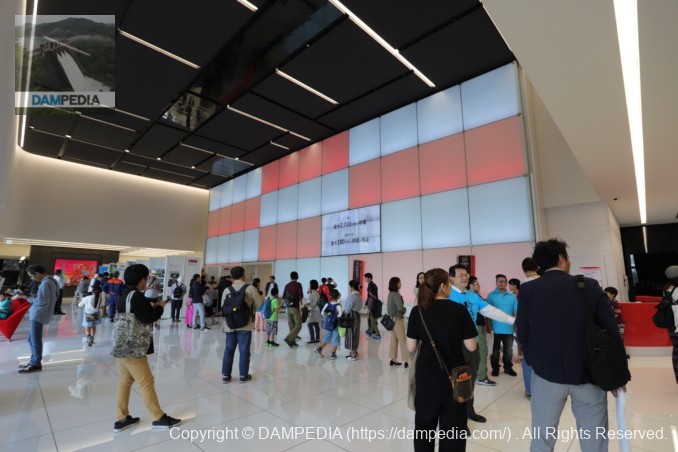
Buraaichi -Understanding Aichi through its history and topography
red salamander (Hynobius kimurae)
This is a vehicle I definitely wanted to see. While several exhibits were cancelled due to the recent typhoon No. 19, it seems that the Red Salamander was not requested to go out.
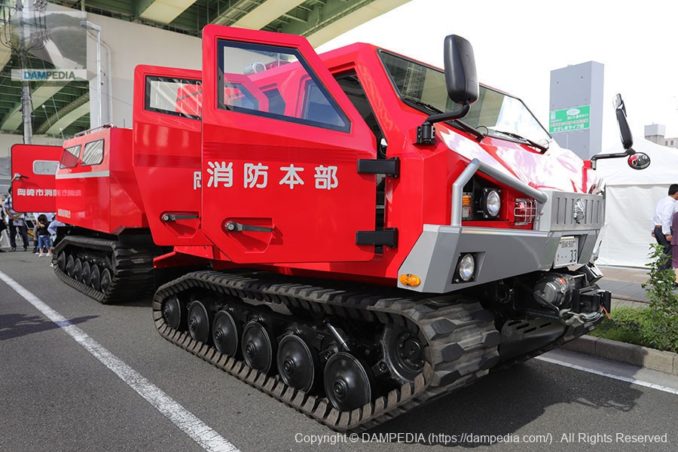
sea slug (various orthogastropod species, esp. of order Nudibranchia)
This is another vehicle I wanted to see.
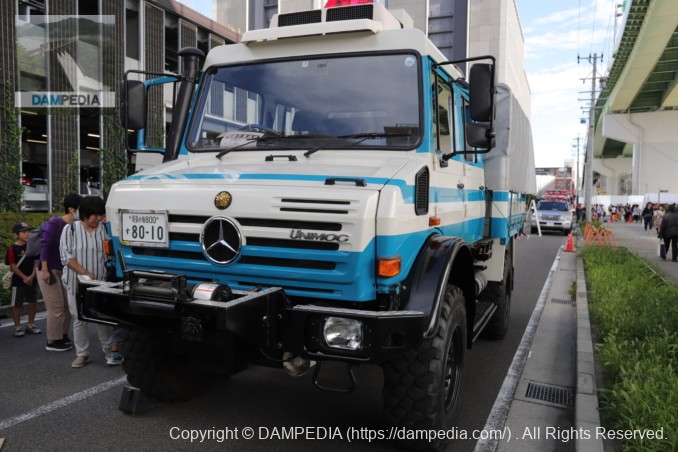
Surviving Flood Damage
After looking around the exhibition, I decided that, as a dam enthusiast, I should see something in the "wind and flood damage" category, so I attended the session "Gekiru" from Flood Damage. The participants will be given a handout, which is actually a book that would normally cost 1,500 yen.
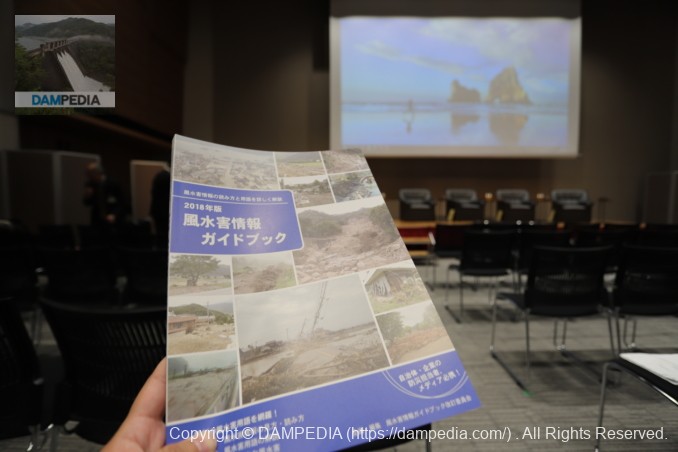
Greetings by Ichiro Matsuo
The session began with opening remarks by Ichiro Matsuo (Visiting Professor, Center for Integrated Disaster Information Research, Interfaculty Initiative in Information Studies, Graduate School of Interdisciplinary Information Studies, The University of Tokyo), who explained the situation of the site visit due to Typhoon No. 19.
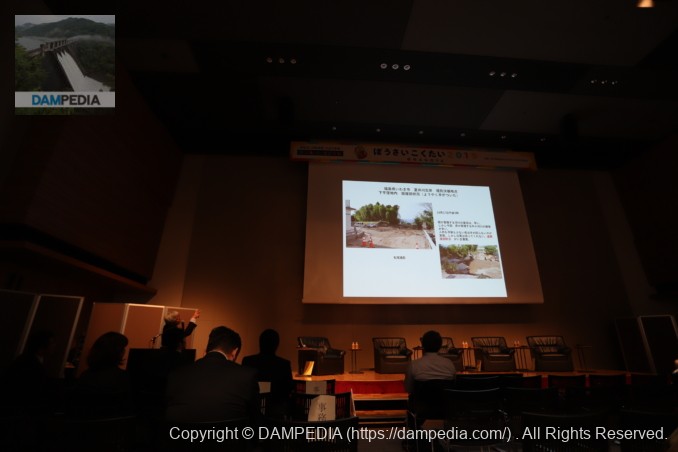
Temporary restoration of the left bank of the Natsuigawa River, Iwaki City, Fukushima Prefecture, in the Shimohirakubo area
The rivers managed by the prefectural government are out of reach due to lack of manpower and budget, but restoration cannot wait. Furthermore, the number of construction companies has decreased drastically due to the decrease in public works projects. Furthermore, the situation seems to be quite dire, as they are still recovering from the disaster of the Great East Japan Earthquake.
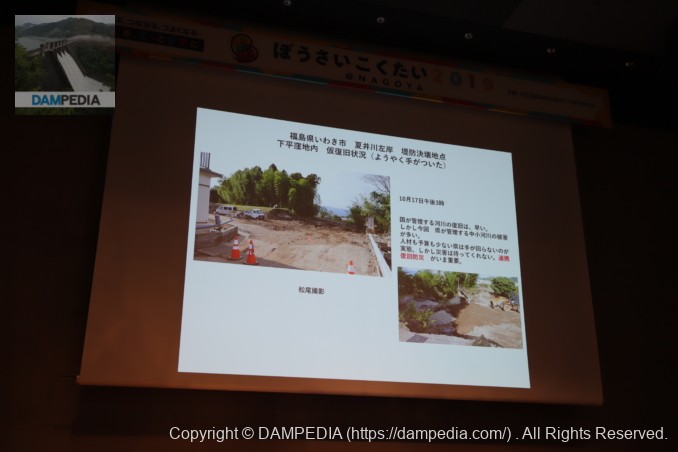
Temporary restoration of the Adatara River left bank levee break in Motomiya City, Fukushima Prefecture
Restoration status with tons of sandbags.
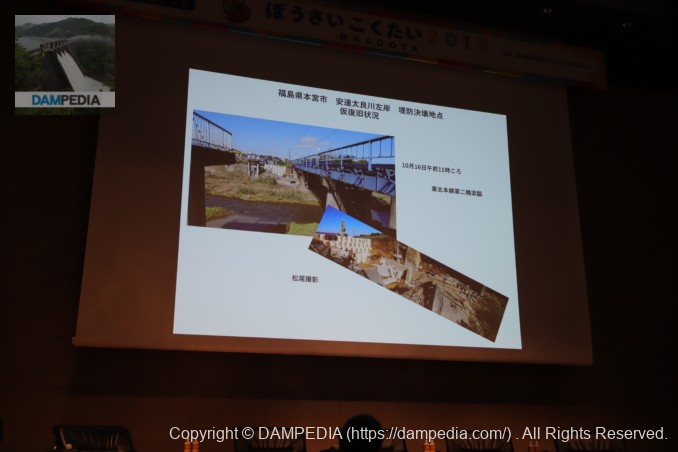
Piping of Adatara River, Motomiya City, Fukushima Prefecture
The story is that piping was occurring on a seemingly undamaged levee. In fact, it means that the levee was on the verge of breaking.
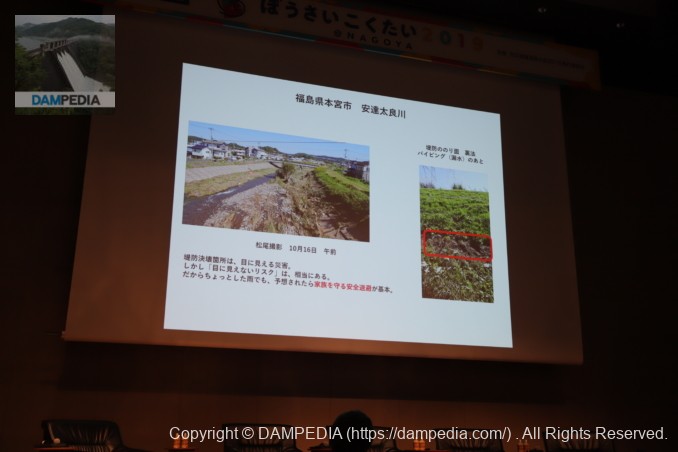
Scouring of levee Iwaki City, Fukushima Pref.

Evacuation of 33,000 people in Adachi Ward to designated evacuation centers
Off topic. The story is that 33,000 people out of a population of about 700,000 were evacuated. I thought this was too few, but I heard that this was still a successful result. The mayor of Adachi Ward also called for evacuation via video.
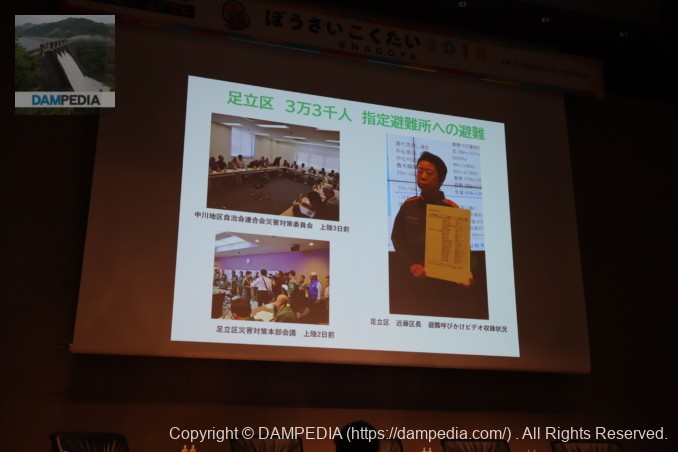
Three pillars to protect life

Today's Session

The government has incorporated "alert levels" into disaster prevention information starting this year.
Mr. Ryoichi Suga of the Cabinet Office was scheduled to speak, but he was unable to attend due to the response to Typhoon No. 19, so Mr. Masato Nishida, Director of the Shonai River Office of the Ministry of Land, Infrastructure, Transport and Tourism, will begin his commentary in his place at short notice.
Basic Attitude Toward Evacuation
Since there are limits to government-led hardware and software measures, the government aims to create a society in which residents are aware that they must protect their own lives, and the government will do its utmost to support residents in taking appropriate evacuation actions.
In fact, recent torrential rain disasters have caused problems such as people not evacuating despite being informed of the danger, or returning to their homes because the rain has stopped even though evacuation orders have been issued.
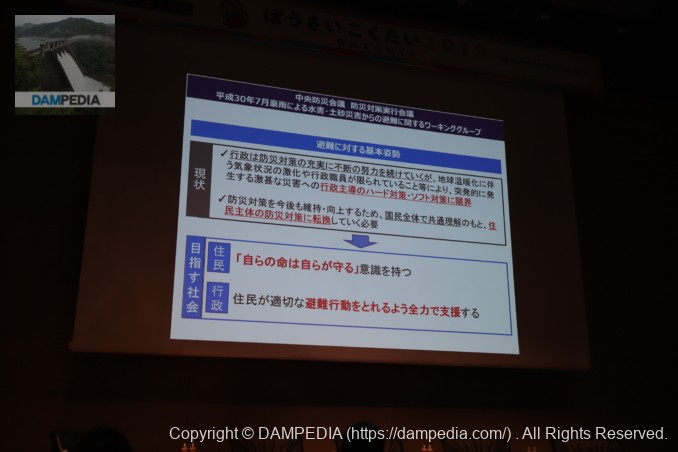
Example of enhanced evacuation measures (alert level)
The "alert level" was introduced this year.
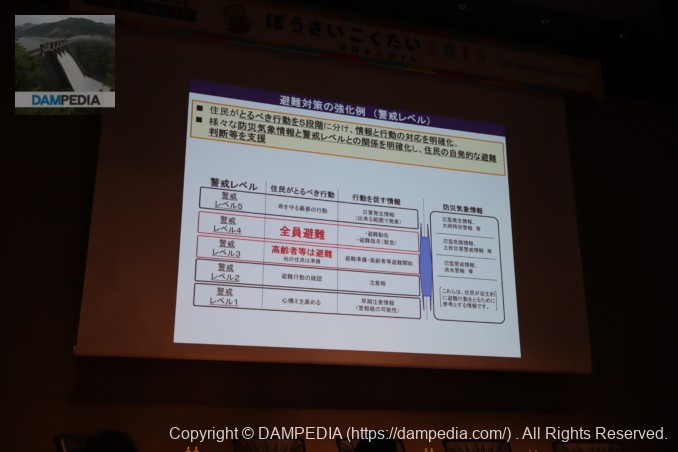
Example of enhanced evacuation measures (call if you have to run)
It is good that the software has been developed, but the story is that it is difficult to reach the elderly because of the use of the Internet and smartphones, and that people will not move unless others tell them to do so, so families should call directly to call for evacuation action.
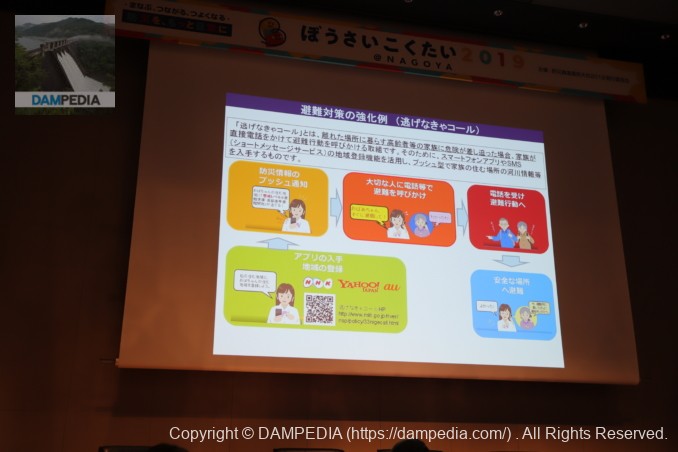
Examples of enhanced evacuation measures (disaster and evacuation cards)
These cards are being worked on at the company I work for.
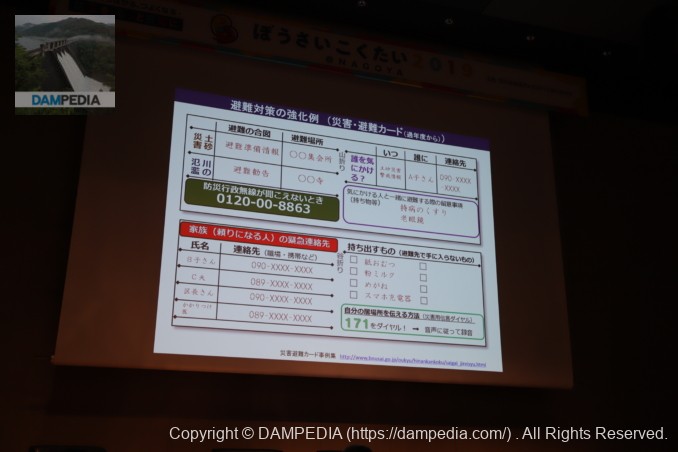
Looking back at the current runoff season

Alert level Looking back
Many felt that the alert level was well recognized and communicated.

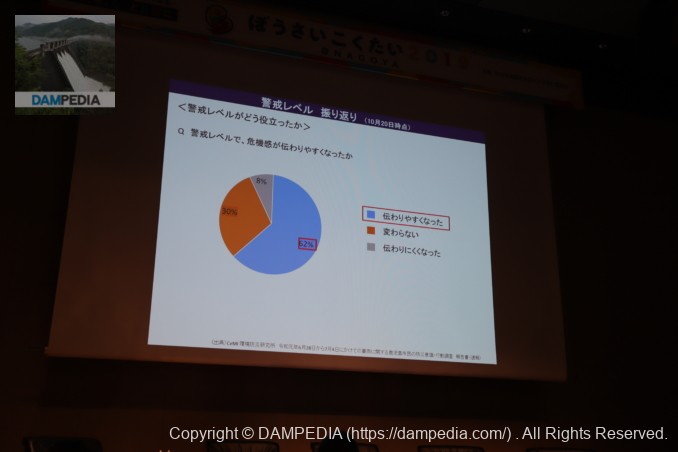
Alert level Reflection (actual condition of evacuation)
38.8% took some kind of evacuation action. There is still a need to make this information known to the public.

Video on the alert level for disaster prevention by the Cabinet Office
The session concluded with a video on the alert level from the Cabinet Office. (What was actually played was a digest version of the following video)
Shonai River Improvement and Reconstruction of a Combined Disaster Prevention Society
Mr. Masato Nishida, Director of the Shonai River Office, Ministry of Land, Infrastructure, Transport and Tourism, will continue the presentation on the Shonai River.
Shonai River Watershed Overview
They say it is the average watershed area of the rivers managed by the government. However, there are considerable assets in the area, and with the Linear Shinkansen Line in the works, they expect to see further development in the future.
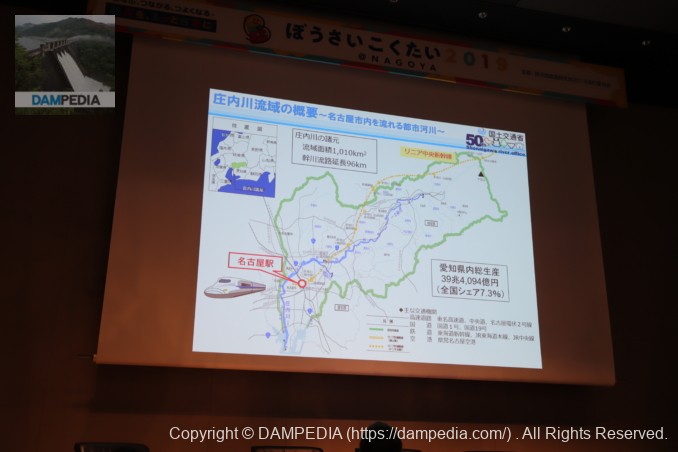
Shonai River flood control measures
He said that the goal regarding flood control of the Shonai River was based on the torrential rains in Tokai in 2000 AD. Since then, there have been no cases of levee failures in this region for nearly 20 years, but the other speakers also mentioned that it was just a coincidence that it had not happened, and that there was no guarantee that it would happen again in the future.
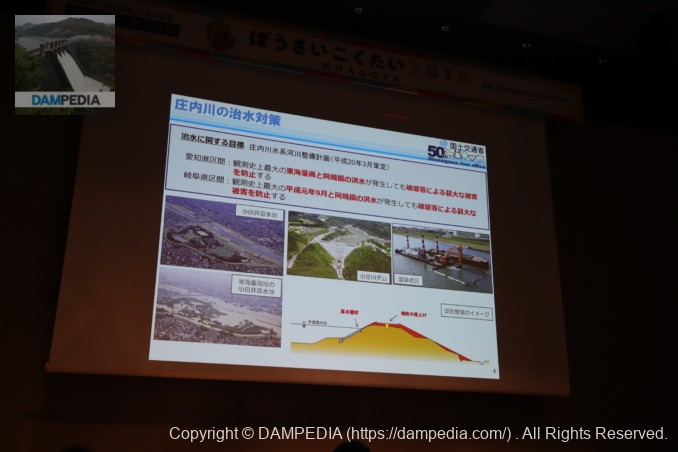
There will always be a major flood that the facility cannot protect against.
Due to the Kinugawa River levee breach in 2015, he proposed a vision to rebuild a "flood prevention disaster awareness society" in Kasumigaseki.

Initiatives for the Vision of Rebuilding a Society Conscious of Flood Prevention and Disaster Prevention

Goals set by the Conference to Protect Lives from Flooding of the Toki and Shonai Rivers
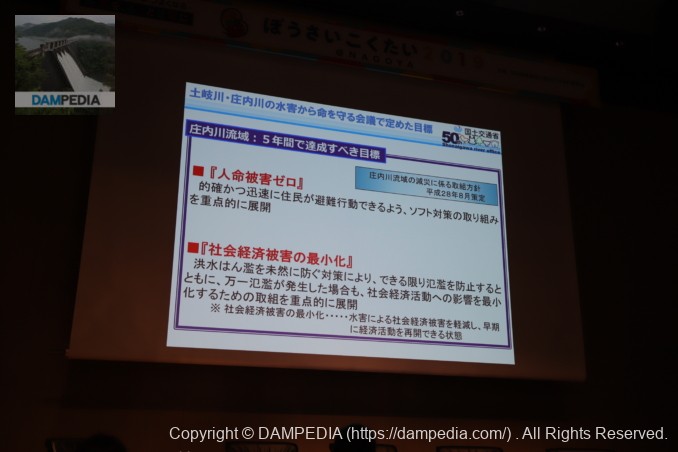
Dissemination of risk information leading to action by residents, etc.

Provides real-time information that triggers evacuation actions

Flood Damage Countermeasures in Nagoya City
Next up was a presentation by Mr. Masanori Banno, Deputy Director of the Nagoya City Disaster Prevention and Crisis Management Bureau, on flood countermeasures in Nagoya City.
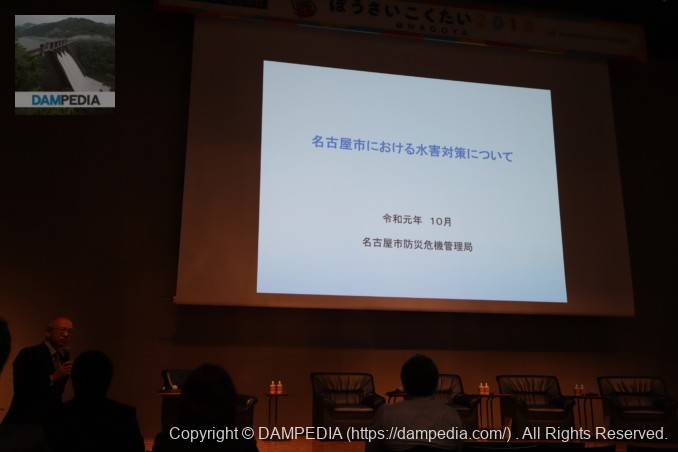
Major Past Floods in Nagoya City
Isewan Typhoon, Tokai Torrential Rain, etc. were introduced.
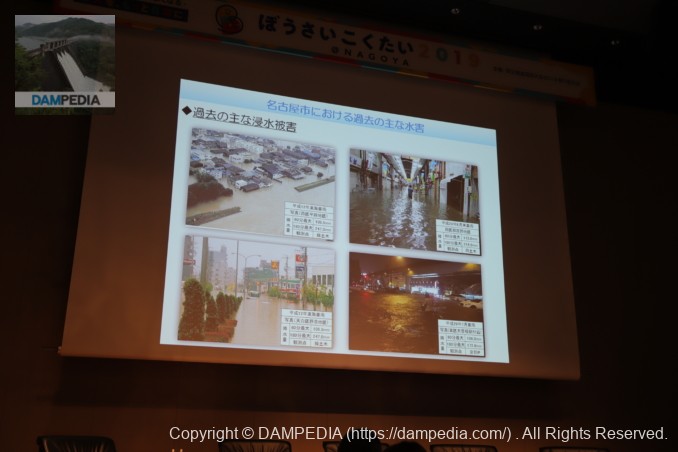
Flood Control Facility Development in Nagoya City to Date
An emergency rainwater improvement project was implemented in the wake of the Tokai torrential rains. The project focused on areas damaged by the torrential rain in Tokai.
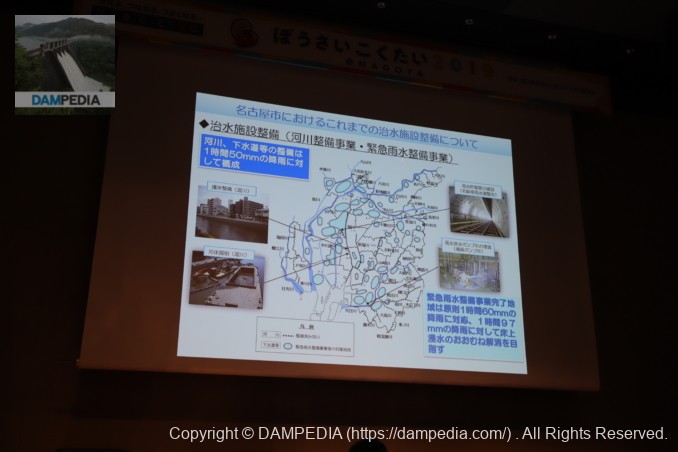
What is the Nagoya City Comprehensive Drainage Plan?
The Nagoya City Comprehensive Drainage Plan was revised in May 2028 in response to recent heavy rainfall disasters.
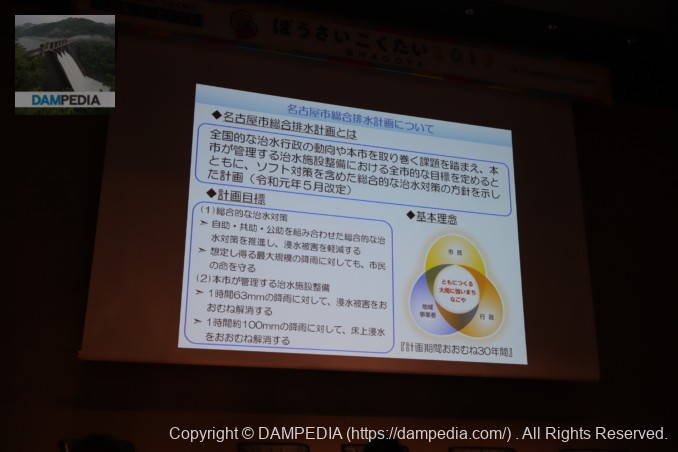
Challenges facing the City of Nagoya and the four policy pillars in the Comprehensive Drainage Plan
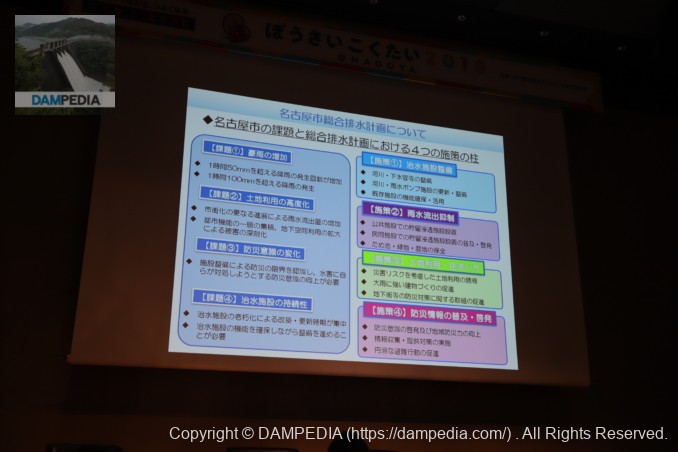
(1) Flood control facility development
The Nagoya Central Rainwater Regulating Basin is a 5-meter tunnel bored about 5 km long, and about 1/3 of it is now complete. A new Hirokawa pumping station, larger than Nagoya Castle, will be built to discharge the water into the Nakagawa Canal, a major undertaking.
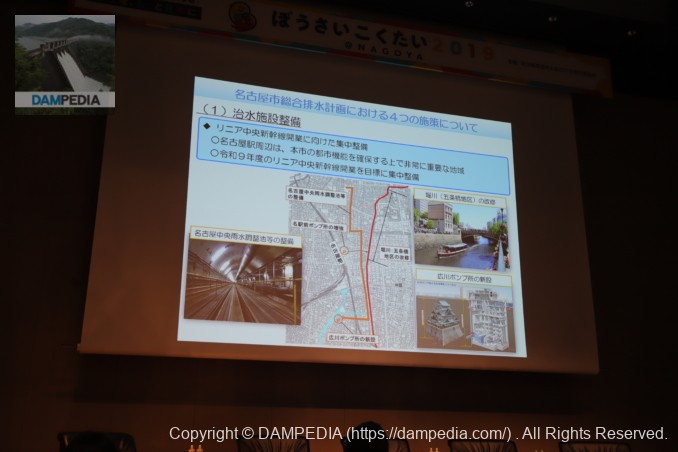
(2) Stormwater runoff control (3) Land use and housing
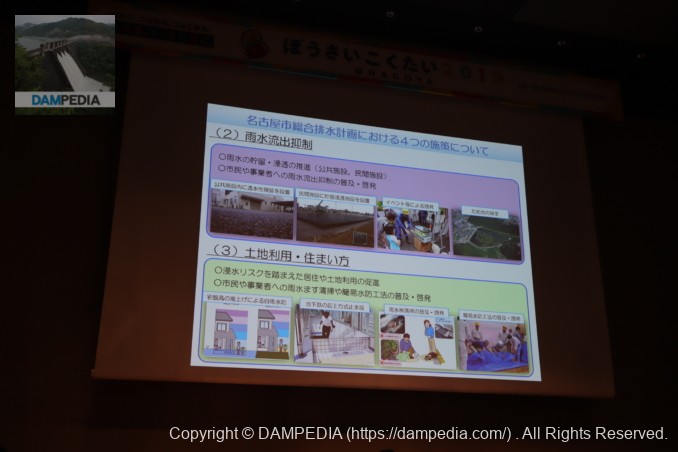
(4) Dissemination and awareness of disaster prevention information

Aiming to Improve Disaster Preparedness
In addition to this, they are also working to unravel the history of the area through the names of old towns and places, and to learn about the past of the area. I thought this was a good initiative, as one could learn from the place names that the area was actually the site of many landslides.
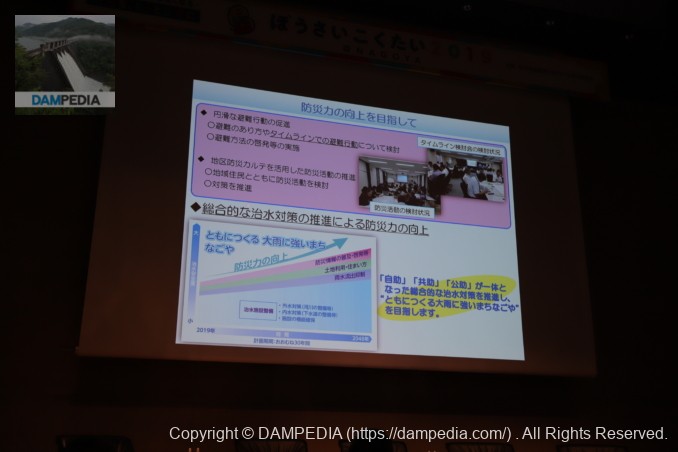
Nagoya Station Area Underground Space Timeline Initiative
Mr. Akihiko Kishida, Executive Director of the Nagoya Station Area Urban Development Council, explained the initiatives at Nagoya Station.
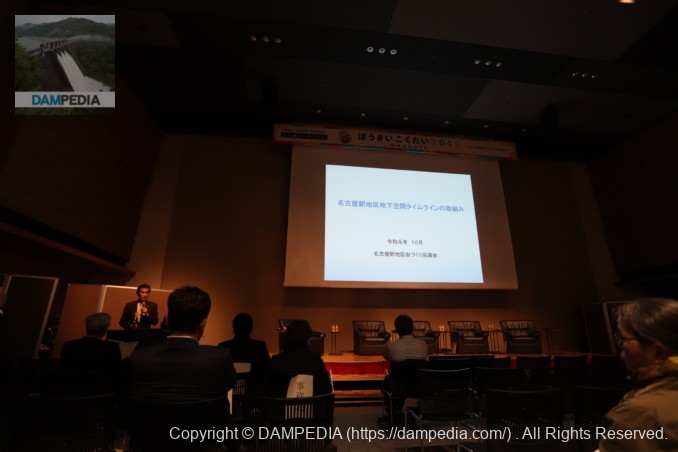
Overview of the Nagoya Station Area Shonai River Timeline Study Group
If the left bank of the Shonai River bursts its banks, Nagoya Station is expected to be inundated by 2 meters of water. Incidentally, I am currently working in Fushimi, Naka-ku, Nagoya, but my home is further west from Nagoya Station, so I will not be able to return home if Nagoya Station is flooded.
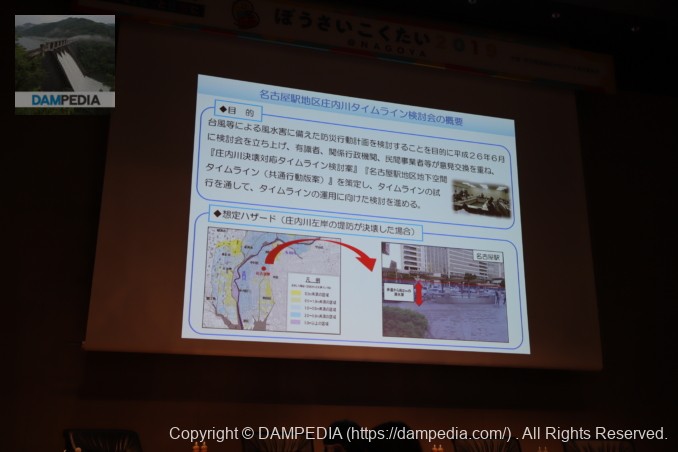
Nagoya Station Area Underground Space Timeline (Draft Common Action Version)
When it rains, Nagoya residents flee to the basement. However, since they cannot see what is going on outside and flooding damage is expected, a timeline of actions is being compiled. Incidentally, there are many businesses in the Nagoya Station underground mall, including those in the basements of buildings (Esca, Unimall, Gatewalk, etc., etc., etc.), so just putting it all together seems like a lot of work. Until now, they have had to deal with this on a facility-by-facility basis, but since there is a limit to the capacity of facilities alone, they are putting it together for all facilities.
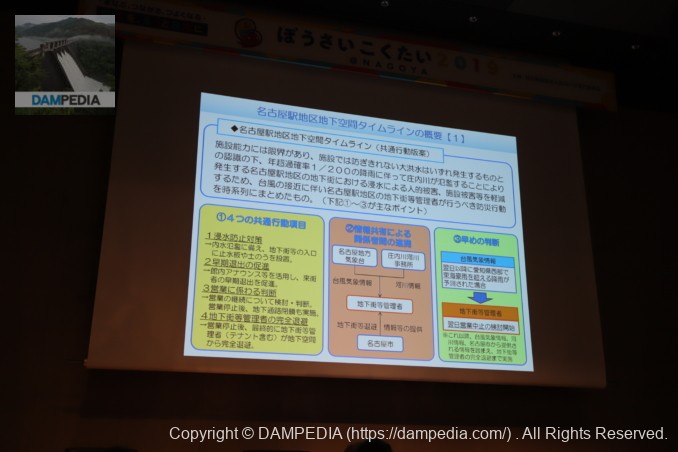
Nagoya Station Area Underground Space Timeline Overview
They have established a timeline according to the water level of the Shonai River.
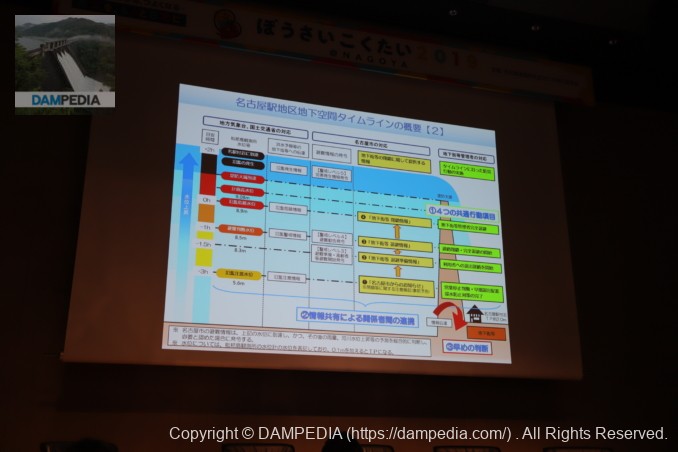
Nagoya Station Area Underground Space Timeline (Shared Action Version Draft) Outline
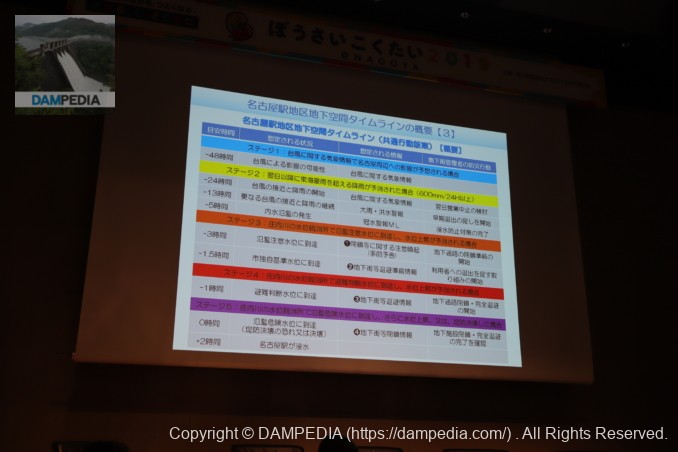
Dissemination and verification of Nagoya Station area underground space timeline
The timeline was not only established, but a desk exercise was conducted two years ago. They said that it brought to light some realizations and issues, and these issues are being adjusted for the next desk exercise.
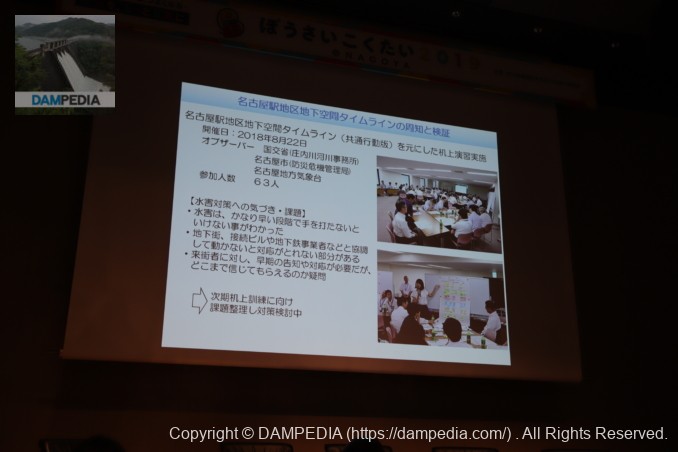
Installation of flooding sensors to monitor road flooding and deploy information
They installed flooding sensors on Sakura-dori and sent out road flooding warning e-mails to members of the Nagoya Station Machizukuri Council to trigger disaster prevention actions.

Further development of the Nagoya Station area underground space timeline
These efforts are being upgraded and upgraded.
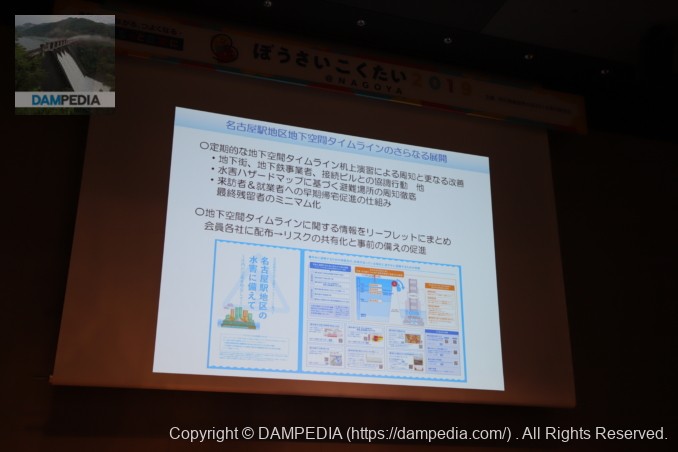
Video introduction about people who had difficulty returning home during the torrential rain in Tokai
Chukyo TV announcer Kazuteru Sato introduced footage of people having difficulty returning home at Nagoya Station during the Tokai torrential rainstorm. He said that many people were stuck at Nagoya Station because they had to wait for 5 hours for cabs, could not take trains, hotels were full, cell phones were congested, and the Shinkansen bullet train was out of service.
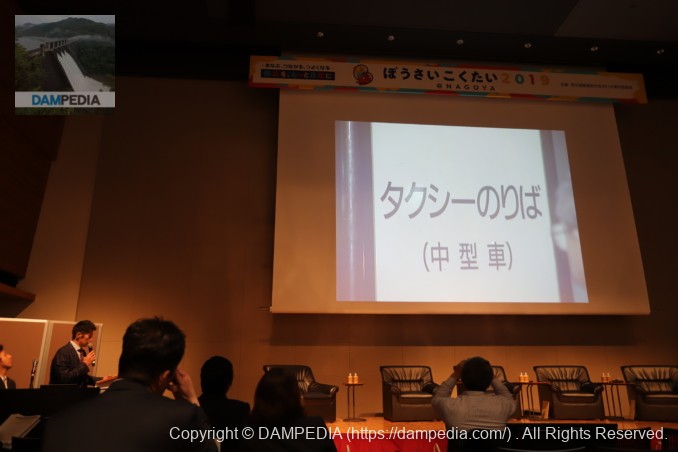
discussion
Finally, a discussion was held on how to share the risk of flooding, how to share the sense of badness with the community and institutions, and how to get away with it.
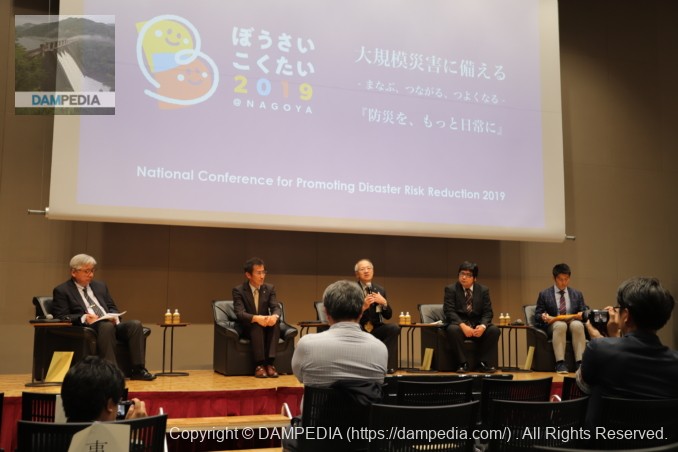
Akihiko Kishida: "We need to share the bad news because most people at Nagoya Station don't think it will be flooded."
Mr. Masanori Banno: "In Nagoya City, hazard maps are distributed to all households, but we do not have figures on how many people receive and properly read them, so we would like to work with the mass media and others to ensure that people understand them.
Mr. Masato Nishida: "The issue is how to convey the information about the expected damage, as it has not been conveyed to the public as if it were their own personal experience.
Kazuteru Sato: "Since Nagoya City, Nagoya Station, and the Shonai River are being tackled in various ways, people may think they are safe, but I want to tell them that they can protect themselves by themselves.
He also noted that the three Tokai prefectures had been relatively successful in taking disaster-prevention actions in advance of Typhoon No. 19: JR had decided to cancel its planned service and supermarkets had been informed in advance that they would be closed. This may have led them to act in advance.
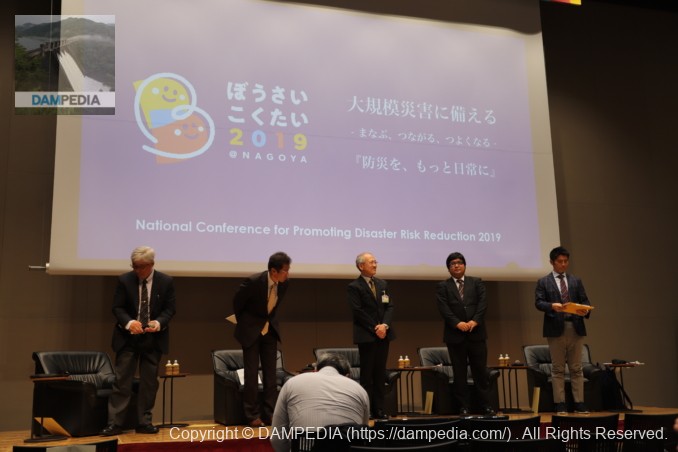
Professor Matsuo concluded by saying, "I hope that people will not think of flood damage as a fire on the other side of the river, but rather protect their lives and take what they have heard today as food for thought, because we do not know when heavy rains will be brought to Nagoya and the Tokai region.
In the disaster prevention operation during the abnormal flooding at Shiroyama Dam during Typhoon No. 19, those who did not escape when the first announcement was made at 3:00 p.m. were blamed for the situation, saying that it was strange that there were two or three changes. In last year's torrential rainstorm in western Japan, there were people who did not escape even though evacuation orders were issued. Also, as mentioned at the beginning of this article, 70% of the people in Hiroshima did not escape.
The challenge is "how to escape as quickly as possible," but unfortunately, people are slow creatures. However, I believe that people can be guided by calling out to them or by giving them a sense of something unusual and out of the ordinary. I am sure that the readers of this article are highly aware of disaster prevention, so I would like to conclude this article by saying that if we can take the initiative in guiding people to escape, we may be able to save lives. Thank you very much.
Next year's BOSAI Kokutai will be held in Hiroshima. If you are in the area, please come!
bonus
That glasses girl idol, Ms. Ami Tokihigashi was performing on stage for children as a disaster prevention specialist. I think it is a wonderful activity.
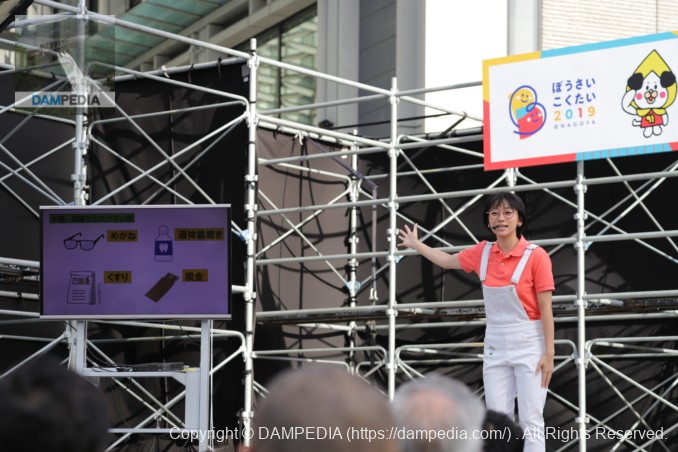



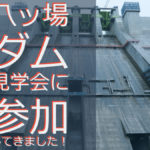
Comment